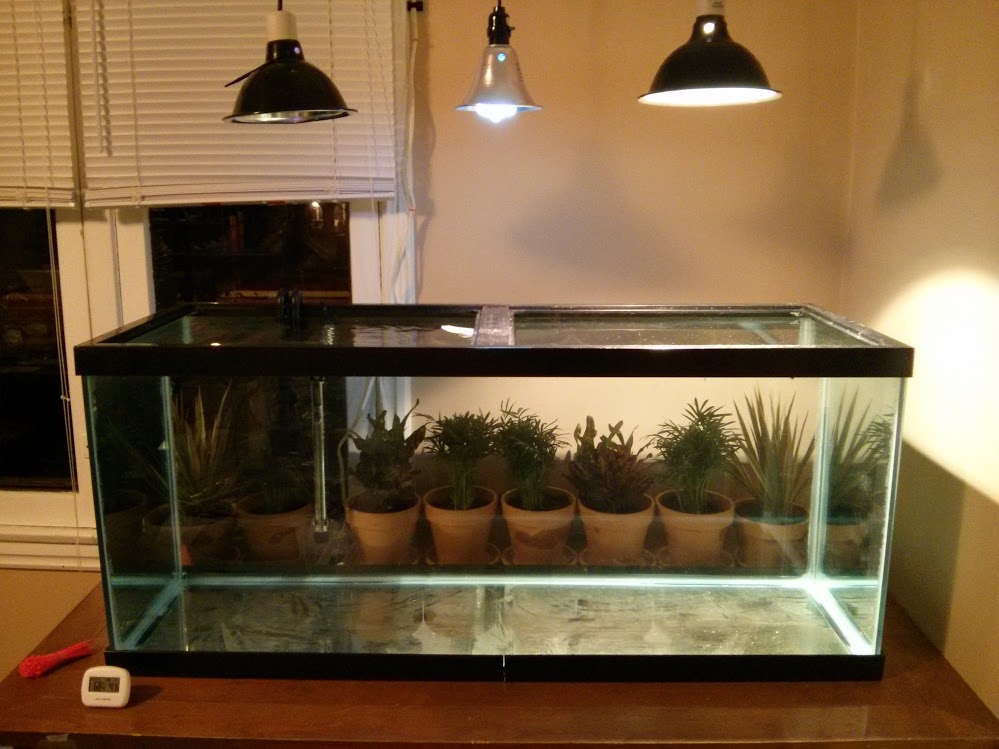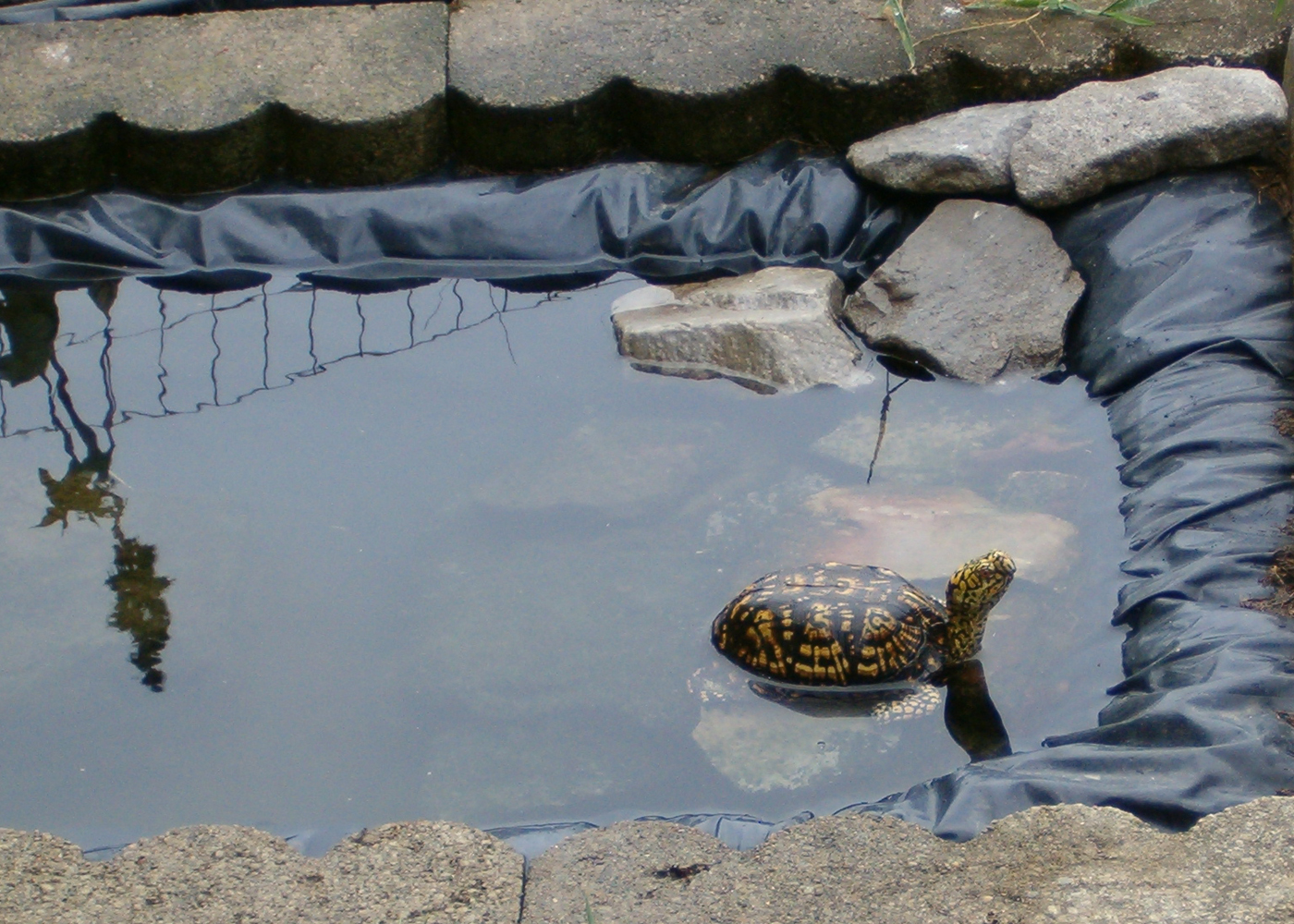Turtle setups vary from species to species, and for the sake of keeping it simple we will also include setups for tortoises below.
There are three ways to classify turtles.
- Aquatic
- Semi Aquatic
- Land Turtles
Different types of turtle setups
1 – 2. Aquatic Turtles and Semi-Aquatic

Aquatic turtles are just that, turtles that stay in water most of the time. The need a tank, heating, lighting, and a place to bask as a minimum.
Choosing the size of tank varies on the size of your turtle species and usually the larger the turtle the more difficult and expensive the setup becomes.
Check the below guides for more about water turtle setups.
Indoor Setups
- How to set up a turtle tank (general guide)
- How to set up a red eared slider tank
- How to setup an indoor turtle pond
Outdoor Setup
In addition to those general guides we have some guides about things you will need for your setup which mostly relate to indoor. For outdoor setups filtrations is the most relevant though it is explained in detail in the guide linked above.
Filtration
All water turtle setups will need a filter for your turtle tank. There are different types including undergravel, canister, and the types that you hang on the side of the tank.
Check the guide to find out what filter is best for your turtle tank.
Heating
In order to ensure the climate is correct for your turtle you will need to make sure the water is heated to the correct temperature using a water heater.
Learn more about what the best heater for your turtle tank is in our guide.
Plus you will also need to make sure you have a basking spot for the turtle which will also require a heat source like a mercury vapor bulb, or a normal heat bulb.
Lighting
UVB lighting is very important as this is how the turtles synthesise and absorb their vitamins along with a heat source.
If you don’t provide this they can develop health issues including meatabolic bone disease.
You can do this in two ways, either use only a UVB bulb or buy a bulb that uses both UVA and UVB. UVA is the heat source and UVB is the ultraviolet light.
UVB bulbs need replaced every 6 – 8 months because they wear out over time.
Find out more from this UVB bulb guide for turtles.
Substrate
Substrates are optional and many people choose gravel, or to leave the bottom empty.
If you do choose to add gravel, make sure it is large enough so that your turtles are unable to eat them. You don’t want them ingesting a rock as this can cause health issues.
Plants
Plants are one way to really make the environment feel like a natural habitat and they look cool too. There are some things to consider like ensuring they aren’t poisonous, but also that you don’t choose plants where they can get stuck and drown.
Our turtle plant guide will give you a walkthrough about what you should think about as well as some good options you can choose today.
Accessories
Finally we come to accessories like decorations, but not only that. Caring for turtles can be relatively easy, but you need to set everything up to be automated. Feeding, lighting, and heating are the basics of what need done regularly.
Feeding you can automate using an automatic turtle feeder. Lighting you can put on a timer, and for the heating as a safeguard you should highly consider adding a thermostat.
3. Land Turtle Setups
Land turtles include both tortoises and box turtles and have similar requirements to the aquatic turtles, minus the water and tanks.
Both tortoises and box turtles can be kept indoors or outdoors, but setup size will vary depending on the tortoise species or box turtle species you have.
Some tortoises get very large and an outdoor enclosure is basically the only option.
Below are the minimum things needed for a tortoise or box turtle you are going to keep indoors.
Tortoise setup guide
- Indoor & Outdoor tortoise setup guide
Box turtle setup guide
- Box turtle setup guide
Enclosure
You will need either a tortoise table, a larger terrarium or some other type of enclosure to house your pet.
Lighting
UVB is a key thing required for your tortoise or box turtle to absorb their vitamins into their body.
Without this there is the possibility of metabolic bone disease and also pyramiding causing them to be deformed.
Heating
Heating can be provided from either a UVA bulb or from a heat pad. Many times people may use a light on one side and heating pad on the other.
What is important is that there is a temperature gradiant (hot and cold side). Having that allows the animal to be comfortable.
Accessories
Accessories include plants, hiding places and water dishes. When adding a water dish it is important that it is shallow and can only come up to the tortoise or box turtles neck.

Tortoises can’t swim and box turtles don’t really swim either. You don’t want to give them any opportunity where they could drown.
Wrap Up
Creating the perfect turtle setup is one of the most fun things about owning pet turtles and tortoises. If you put some time into it, you will be able to make a very nice habitat for yours.
